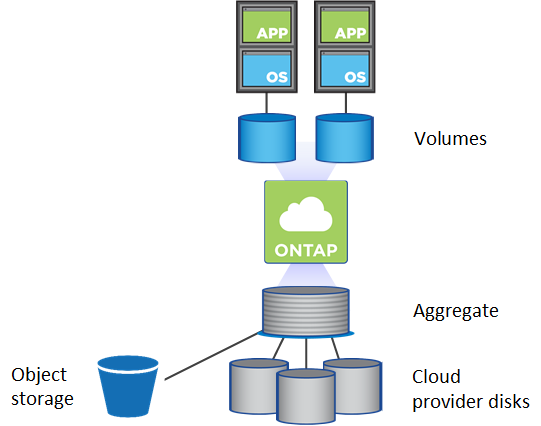Disks and aggregates used for Cloud Volumes ONTAP clusters
 Suggest changes
Suggest changes


Understanding how Cloud Volumes ONTAP uses cloud storage can help you understand your storage costs.

|
All disks and aggregates must be created and deleted directly from BlueXP. You should not perform these actions from another management tool. Doing so can impact system stability, hamper the ability to add disks in the future, and potentially generate redundant cloud provider fees. |
Overview
Cloud Volumes ONTAP uses cloud provider storage as disks and groups them into one or more aggregates. Aggregates provide storage to one or more volumes.

Several types of cloud disks are supported. You choose the disk type when you create a volume and the default disk size when you deploy Cloud Volumes ONTAP.

|
The total amount of storage purchased from a cloud provider is the raw capacity. The usable capacity is less because approximately 12 to 14 percent is overhead that is reserved for Cloud Volumes ONTAP use. For example, if BlueXP creates a 500 GiB aggregate, the usable capacity is 442.94 GiB. |
AWS storage
In AWS, Cloud Volumes ONTAP uses EBS storage for user data and local NVMe storage as Flash Cache on some EC2 instance types.
- EBS storage
-
In AWS, an aggregate can contain up to 6 disks that are all the same size. But if you have a configuration that supports the Amazon EBS Elastic Volumes feature, then an aggregate can contain up to 8 disks. Learn more about support for Elastic Volumes.
The maximum disk size is 16 TiB.
The underlying EBS disk type can be either General Purpose SSDs (gp3 or gp2), Provisioned IOPS SSD (io1), or Throughput Optimized HDD (st1). You can pair an EBS disk with Amazon S3 to low-cost object storage.
Tiering data to object storage is not recommended when using Throughput Optimized HDDs (st1). - Local NVMe storage
-
Some EC2 instance types include local NVMe storage, which Cloud Volumes ONTAP uses as Flash Cache.
Related links
RAID type
The RAID type for each Cloud Volumes ONTAP aggregate is RAID0 (striping). Cloud Volumes ONTAP relies on the cloud provider for disk availability and durability. No other RAID types are supported.
Hot spares
RAID0 doesn't support the use of hot spares for redundancy.
Creating unused disks (hot spares) attached to a Cloud Volumes ONTAP instance is an unnecessary expense and may prevent provisioning additional space as needed. Therefore, it's not recommended.



